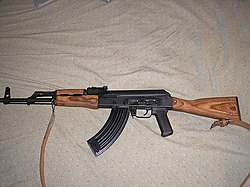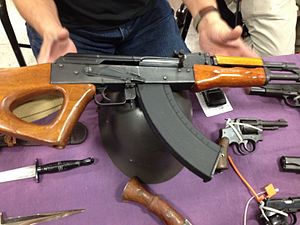Engineering:WASR-series rifles
The Wassenaar Arrangement Semi-automatic Rifles (more commonly referred to as the WASR-series rifles) are manufactured in Romania by the long established Cugir Arms Factory as result of a collaboration between Century International Arms and Cugir.[1]
History and description
According to Century Arms, an American company which imports and modifies the WASR, they are semi-automatic only, single stack variants generally based on the Romanian Model 63, Pistol Mitralieră model 1963/1965 (PM md. 63), and GP 75 AKM rifles Avtomat Kalashnikova Modernizirovanniy (AKM) series of Kalashnikov rifles originally manufactured in Russia. Century decided to import the WASR to meet U.S. demand for AK-style firearms. U.S. federal code 18 USC 922R stipulates that no more than 10 major components of a firearm categorized by federal law as a "semi-automatic assault weapon" could be manufactured outside the U.S.[2] The WASR-series rifles take their name from the 1996 Wassenaar Arrangement,[citation needed] a multilateral export control regime (MECR), the purpose of which is to monitor and limit the proliferation of certain conventional weapons and dual-use technologies.
The WASR-series rifles use a Romanian-made receiver, but lack the dimple (used to center the magazine) above the magazine well seen in the other AK series of rifles. Instead WASRs use internally welded spacer plates to center the magazine. The arrangements of the rivets on the receiver and front and rear trunnions are also different from many other AK derivatives. There are no known clones of the WASR series to date. The lack of dimple and rivet layout allows for positive ID in the many different stock configurations.[3][4]
Construction
WASR-series rifles are manufactured with stamped sheet metal receivers that were originally intended for single-stack magazines. Featuring hard chrome-lined barrels, side-mount scope rail and wooden stocks, WASR-series rifles are commonly imported to the United States by Century International Arms.
In Romania the rifles are manufactured to conform with certain United States firearms regulations including Title 18, Chapter 44, of the United States Code, which defines laws for manufacturing and importing firearms such as semi-automatic only fire.[5] Century Arms modifies the weapon with upgraded fire control groups (i.e. trigger), pistol grips, and plastic folding or collapsible stocks manufactured by TAPCO of Georgia.
Older WASR-series rifles commonly caused trigger slap, which is caused by the bolt slamming backward into the trigger assembly and causing significant pain to the shooter's trigger finger.[6] Beginning in 2007, Century International Arms has installed the TAPCO Intrafuse AK G2 trigger group, eliminating the painful trigger slap problem.[7] Rifles with this trigger group will have "TAPCO USA G2" stamped on the left side of the trigger. Some of these rifles may exhibit canted front sight blocks and gas tubes.[8]
WASR-series rifles are inexpensive and easily customized, with hundreds of aftermarket stocks, muzzle brakes, flash suppressors, telescopic sights, and other accessories available.
Variants
GP WASR-10
The WASR-10 is a post-ban version of the AKM rifle in 7.62×39mm caliber. Factory-original rifles only support single-stack, low-capacity magazines (10-rounds). After import, Century Arms offered WASR rifles modified to accept double-stack, standard-capacity magazines (machining burrs on the magazine well may cause some magazines to fit improperly if the burrs are not removed). Pistol grip and thumbhole stocks were both commonly fitted to WASR rifles.
After the sunset of the 1994 assault weapons ban, importers were able to legally equip WASR-10s with compensators, bayonet lugs, and folding stocks, thus making the GP WASR-10 (with GP standing for general purpose). Some advantages of this rifle are the reliability of the gun and the availability of standardized aftermarket parts.[9]
GP WASR-10/63
The GP WASR-10/63 was built using the same newly-manufactured single-stack receiver and chrome-lined barrel as the GP WASR-10, and the two models are cosmetically similar. However, while the GP WASR-10 was made with new parts, all parts on the GP WASR-10/63 (other than the receiver and barrel) came from a former Romanian military rifle. The original year of manufacture can be seen engraved on the left side of the trunion (the trunion is visible where it protrudes through the receiver on the left side, near the front), along with the original rifle's serial number. Dates seem to range from the early 1960s to the 1980s. Most or all small metal parts are marked with the last few digits of the original serial number. As with other WASR models imported into the United States, Century Arms modified these rifles to accept normal 30-round magazines.
The pistol grip, trigger group, slant muzzle brake and gas piston were replaced with U.S.-made substitutes to comply with U.S. regulations.[10]
There are rumors that the GP WASR-10/63 was built from rejected parts. This is not true. All parts had passed inspection and the original rifle had been accepted into actual military service.
Because the GP WASR-10/63 originated as a Romanian military rifle, Century Arms sold them with many of the original rifle's accessories, such as a bayonet, oil bottle, magazine pouch and cleaning kit.
WASR-22
The WASR-22 fires the .22 Long Rifle cartridge. They are designed as trainers or starter AKs. They usually ship with two 10-round magazines. There are reports of jams caused by the smaller shell casing lodging in the receiver cover and blocking the action. Most people replace the top cover with a military one or adjust the tension of the extractor spring, which is under the bolt assembly.
WASR-2
The WASR-2 is essentially a WASR-10 chambered in 5.45×39mm, and usually does not come with any accessories (muzzle brake, bayonet), especially if it is ordered straight from Century Arms.[11]
WASR-3
This commercial export version of the WASR is chambered in 5.56×45mm NATO (which can also safely fire the .223 Remington round). It usually comes in the same configuration as the WASR-2. These have known problems with jamming or failure to feed. This may be due to low quality magazines, or their followers. The WASR-3 was originally supplied with surplus 5.45×39mm AK-74 magazines, which do not reliably feed the 5.56/.223 cartridge. People have used Wieger magazines with some success. Century Arms eventually began including Romanian copies of the reliable Wieger magazine with these rifles. Some switch the follower of an AK-74 magazine with one from Robinson Arms.[12] Israeli Galil steel magazines are also known to work without modification in the WASR-3. Some owners have also modified the rifle to accept Bulgarian Circle-10 5.56 magazines, or Polish Beryl 5.56 magazines. These sometimes require some material to be removed from the receiver center support bar.
See also
- SA M-7
- Saiga semi-automatic rifle
- Zastava PAP series
References
- ↑ http://www.tactical-life.com/firearms/centurys-gp-wasr-10/#centurys-gp-wasr-10-2
- ↑ http://www.thetruthaboutguns.com/2010/05/don-gammill-jr/gun-review-century-arms-wasr-10-romanian-ak/
- ↑ http://www.thetruthaboutguns.com/2010/05/don-gammill-jr/gun-review-century-arms-wasr-10-romanian-ak/
- ↑ http://www.tactical-life.com/firearms/centurys-gp-wasr-10/#centurys-gp-wasr-10-2
- ↑ https://www.law.cornell.edu/uscode/text/18/922 Section 922(r.)
- ↑ "Ak-47.net.". Archived from the original on July 28, 2005. https://web.archive.org/web/20050728145010/http://www.gunsnet.net/Linx310/model.htm.
- ↑ "Archived copy". http://www.tapco.com/products/ak/index.php?_a=viewProd&productId=56.
- ↑ http://www.gunsnet.net/Linx310/cant.htm
- ↑ "Romanian Kalashnikov Rifles". http://www.gunsnet.net/Linx310/model.htm.
- ↑ https://www.gpo.gov/fdsys/pkg/CFR-2002-title27-vol1/xml/CFR-2002-title27-vol1-sec178-39.xml
- ↑ "Romanian Kalashnikov Rifles". http://www.gunsnet.net/Linx310/model.htm.
- ↑ "Romanian Kalashnikov Rifles". http://www.gunsnet.net/Linx310/model.htm.
External links
- American Rifleman review of Century's WASR-10
- Roman-Forums.com - Romanian WASR-10 GP AK-47 Review
- WASR-10.com - Information about the WASR-10 Romanian AKM






